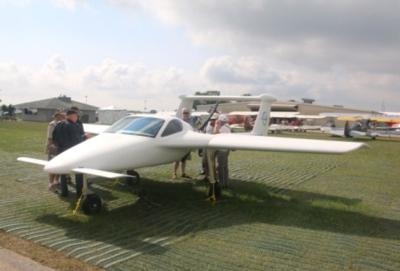Commuter Craft Qualifies As An LSA
By Bruce Brandon
Richard Hogan is working on a better mousetrap in Woodstock, GA which is near Atlanta. His concept is to manufacture a kit-built composite two seat airplane that Hogan says doesn’t compromise on flight performance while still having the advantage of allowing you to drive it from home to the airport comfortably.

Performance is predicted to be impressive. There will be a variety of engines that will be put in the aircraft, determining whether it qualifies as an LSA. Cruise speeds for the 180 hp version will approach 170 mph and have a useful load around 700 lbs. The cabin will accommodate persons who range in height from 5’2” to 6’4” and has a 12 inch console between the two occupants.
The futuristic looking Commuter Craft promises to fill a void in affordable two seat aircraft. The concept is to first build a good airplane that coincidentally has the ability to be driven to the airport. The roadability capability is not the primary emphasis, just a component that will be added after the initial production. The intent of the roadability is for it to be driven from home to the airport , not replace your automobile.
The aircraft has a canard, a high twin tail with an elevator and, most interestingly, a fuselage that is a lifting body. Commuter Craft has found that having an elevator control pitch rather than the canard results in greater control.
Having a lifting body fuselage makes the aerodynamics interesting. At high angle of attack, the cg changes not only for the wing but the fuselage. At very high angles of attack, this can become a challenge to manage. One of the positive aspects is that the airplane won’t stall in the traditional sense but just “mush” at approximately 400-600 fpm. The low aspect wing also adds to higher than normal angle of attack envelope before the stall/”mush” occurs.

The wings will be foldable. There will be an option for this to be done electronically. The initial aircraft will have tires (landing gear) that are smaller than those that will be on the roadable version. It is estimated that the larger roadable tires will reduce cruise speed by approximately 10 kts. When on the ground, the aircraft is propelled by 20-40 hp electric motors that turn the main landing wheels. One ancillary benefit of this is that the this tire propulsion can be used on takeoff to reduce ground run. Sort of like JATO, just different.
The pusher propeller present challenges on the ground. The aircraft can be flown off of grass strips but it is not recommended for gravel strips for obvious reasons.
Development of the aircraft is proceeding aggressively. A 1/3 scale model has flown and the first aircraft will fly in September. Dealers will begin receiving training at the beginning of 2015 and the kits delivered later in the year.
Commuter Craft will have builder assist at its location in Woodstock, GA. They estimate it will only take 3 weeks to build the airframe. The avionics and engine will take another couple of months. So one can go from 0 to flying in around four months.
The cost will depend on what avionics, engine and propeller the owner chooses. Expected prices for a flying aircraft range from just over $100K for the more basic aircraft to around $140K for one with all the bells and whistles.
(Staff images)
 ANN's Daily Aero-Term (10.31.25): Minimum Sector Altitude [ICAO]
ANN's Daily Aero-Term (10.31.25): Minimum Sector Altitude [ICAO] ANN's Daily Aero-Linx (10.31.25)
ANN's Daily Aero-Linx (10.31.25) NTSB Final Report: Airbus A321-271N (A1); Cessna 172N (A2)
NTSB Final Report: Airbus A321-271N (A1); Cessna 172N (A2) ANN FAQ: Follow Us On Instagram!
ANN FAQ: Follow Us On Instagram! Airborne 10.30.25: Earhart Search, SpaceX Speed Limit, Welcome Back, Xyla!
Airborne 10.30.25: Earhart Search, SpaceX Speed Limit, Welcome Back, Xyla!




